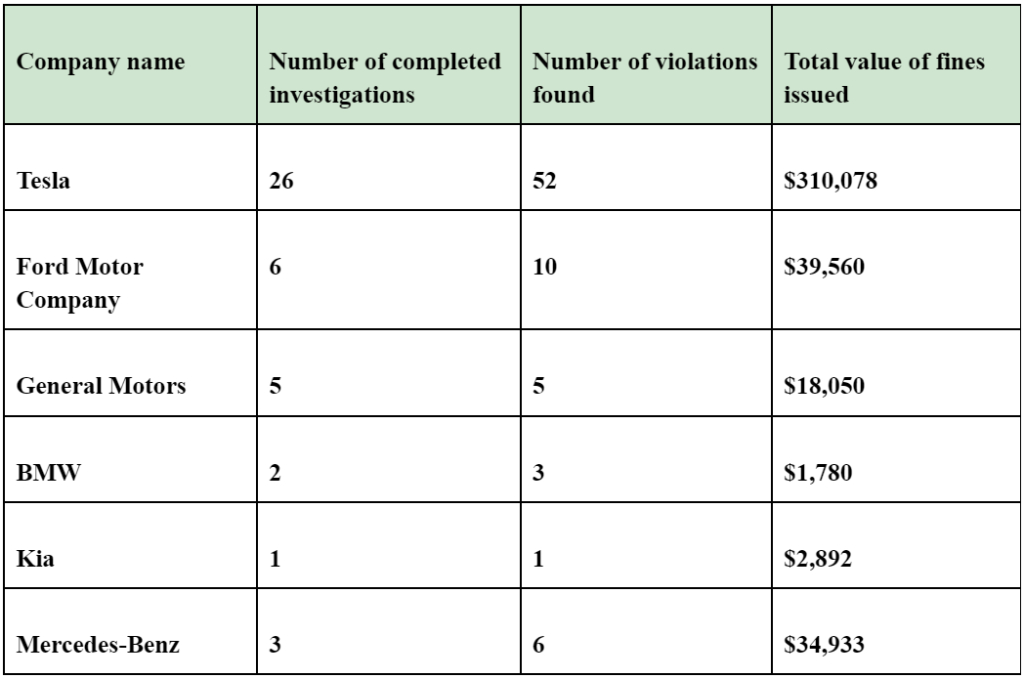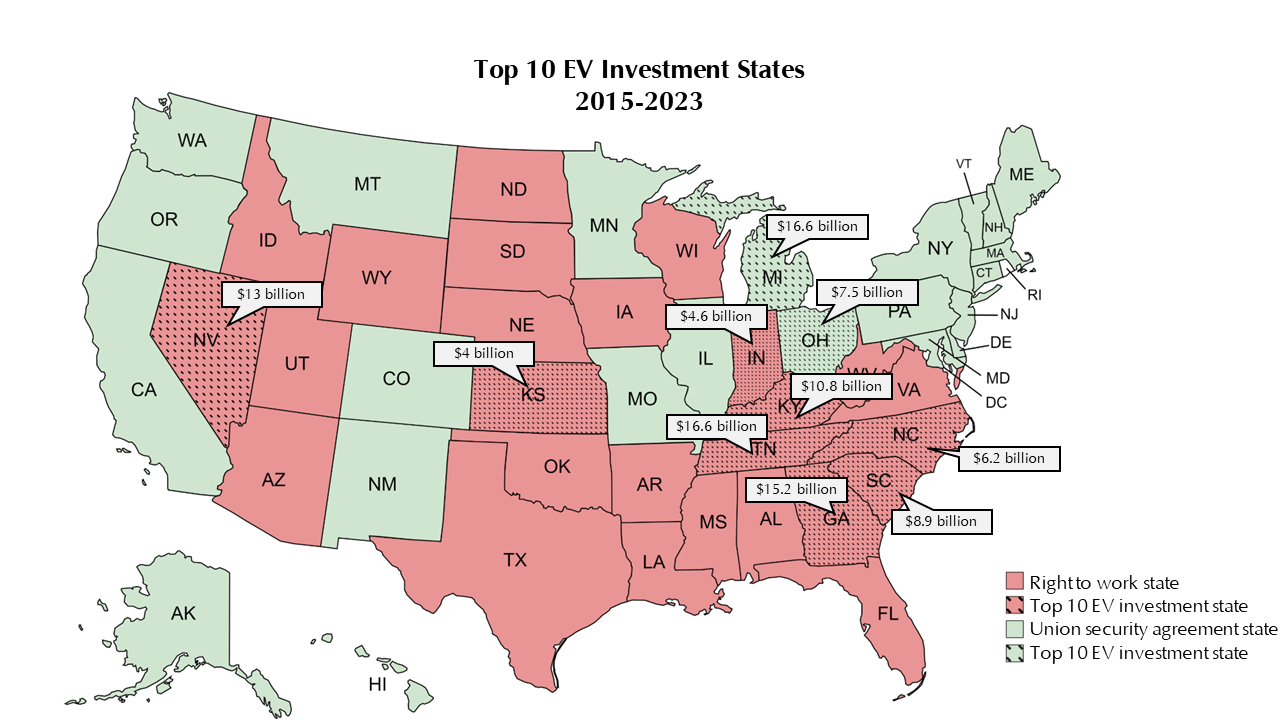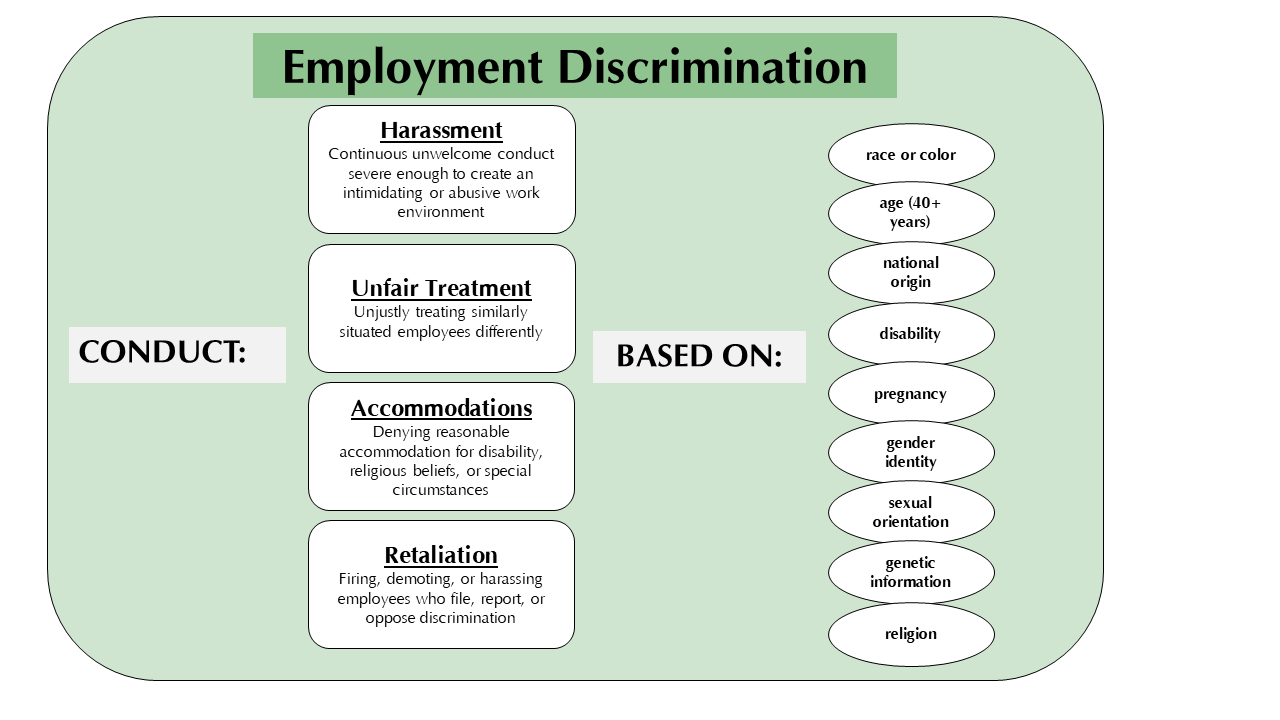Shifting Gears Part II: Labor Rights in the U.S. EV Transition

Source: https://www.flickr.com/photos/fleshmanpix/8737252530
Catalyzed by new legislation, the transition to electric vehicle (EV) and EV battery manufacturing has gained significant traction in the US. The onshoring of EV and EV battery manufacturing has created new jobs in the US automotive industry, already one of the country’s largest, with an estimated 4.3 million employees. Of those, more than 1 million employees work in auto manufacturing. Between 2015 and 2023, at least 125,600 new U.S. jobs in EV and EV battery manufacturing have been announced. This number is expected to grow. At the same time, the phase out of internal combustion engine (ICE) vehicle manufacturing is expected to result in job losses since EVs require less labor to produce.
The EV transition will change the very fabric of the US automotive industry, inevitably impacting workers’ rights. For example, emerging EV automakers and multi-company EV battery partnerships have shifted manufacturing to states with weak unionization laws. The predominantly non-unionized EV industry has also lowered job quality for autoworkers. Many EV manufacturing jobs offer lower wages, fewer benefits, and less growth opportunities than the traditional ICE sector. Furthermore, as EV manufacturing requires fewer laborers and different skills than ICE manufacturing, many workers will need to be retrained to maintain their jobs. Additionally, the EV industry will continue to deal with the myriad of labor rights issues that have always existed in the automotive sector: discrimination, health and safety, child labor, etc.
While labor rights encompass a wide range of issues, from discrimination to paid sick leave, this blog highlights some of the most serious issues in the EV manufacturing sector. The following sections discuss labor rights based on the International Labour Organisation’s (ILO) fundamental principles and rights at work. The US is a member state of the ILO, and as such, it recognizes the following fundamental rights:
(a) freedom of association and the effective recognition of the right to collective bargaining;
(b) the elimination of all forms of forced or compulsory labor;
(c) the effective abolition of child labor;
(d) the elimination of discrimination in respect of employment and occupation; and
(e) a safe and healthy working environment.
Freedom of Association and Collective Bargaining
The rights to freedom of association and collective bargaining relate to the right to join a labor union. According to the U.S. Department of Labor, a labor union is “a group of two or more employees who join together to advance common interests such as wages, benefits, schedules and other employment terms and conditions.” Labor unions have been shown to increase wages, reducing wage gaps especially for women and BIPOC workers. They also reduce health and safety incidents and promote access to paid sick leave and retirement plans.
Under the National Labor Relations Act, employers can neither interfere with nor coerce employees to join a union. The NLRA provides for union-security agreements, by which non-union workers may have to pay a “fair share fee” to cover the union’s costs of representing them. States with legislation prohibiting fair share fees are known as “right to work” states. This type of legislation has roots in white supremacist ideology and continues to perpetrate economic inequality. In fact, in 1961, Martin Luther King Jr. called such right to work laws “false slogans” that “rob us of our civil rights and job rights.”
Unions in right to work states are still required to represent non-union members, which creates a “free rider” problem. As a result, right to work states generally have weaker unions and lower rates of unionization. Employees’ wages are also usually lower, health and retirement benefits are more difficult to access, and discrimination and safety violations are more prominent.
Historically, the automotive sector has had strong unionization representation. In 2021, unions represented 17% of employees in the automotive industry, compared to only 9.3% in the broader manufacturing sector. The unionization of the Big Three automakers – Ford, General Motors, and Chrysler (now Stellantis) – has greatly contributed to the growth of the middle class, thereby cementing the automotive industry as integral to the US economy.
As the US transitions to EVs, the traditional unionization model is being challenged by new EV automakers and anti-union states. Tesla, a leading EV manufacturer, is the only major US auto company without any union representation. Earlier this year, the company was accused of retaliatory firing of employees trying to unionize in its Buffalo, NY gigafactory. Similarly, Toyota, Nissan, Hyundai, Mercedes-Benz, BMW, Volkswagen, and Honda have fought against unionization efforts. Moreover, as automakers form joint ventures with foreign tech companies to produce EV batteries, the ability to form unions in these plants will likely be more difficult, as battery manufacturing lacks an established practice of unionization. The Ultium battery plant in Ohio, a joint venture between General Motors and LG Energy Solution, was the first one to unionize. However, this outcome is less likely in right to work states.
Over the past eight years, 86% of EV-related investments in the US have been concentrated in ten states: Michigan, Tennessee, Georgia, Nevada, Kentucky, South Carolina, Ohio, North Carolina, Indiana, and Kansas. Eight of these states (i.e. all but Ohio and Michigan) have right to work laws in place, presenting significant barriers to labor rights as EV infrastructure expands.
Elimination of Forced Labor and Child Labor
Many industries rely on child labor. In the US, the use of child labor is legal in certain cases, but is highly regulated to safeguard children from dangerous work environments and exploitation. The Fair Labor Standards Act of 1938 was designed to protect children’s educational opportunities and prohibit employment in jobs that risked their health and well-being. Under this act, employing children under the age of 18 for manufacturing jobs is prohibited.
Despite strict regulations, child labor violations in the US have increased since 2015. These violations include, but are not limited to, children in dangerous working conditions, imposing long working hours that interfere with school, and withholding overtime pay. A recent New York Times exposé highlighted a growing trend of US companies using migrant child labor. Since host families often use fraud or coercion to compel these children into jobs instead of going to school, this child labor can also qualify as forced labor.
The US Department of Homeland Security defines forced labor as the use of force, fraud, or coercion to compel individuals to provide labor against their will. While migrants are greatly affected, most forced labor in the United States involves US citizens or individuals with legal immigration status. According to the ILO, forced labor is prevalent in the manufacturing industry, as well as in other low paying industries with little accountability. Though child labor and forced labor are different concepts, they can, and frequently do, occur simultaneously.
Automakers have recently come under scrutiny for using forced and child labor in their manufacturing plants. In Michigan, migrant children produce auto parts for Ford and General Motors. In 2022, Kia and Hyundai Motors received fines because their suppliers employed children in violation of laws prohibiting the use of child labor in the auto manufacturing industry.
As the EV sector grows in the US, automakers must conduct due diligence to eradicate the use of forced and child labor in their supply chains and ensure that they do not contribute to the exploitation of children.
Elimination of Discrimination at Work
Discrimination in the workplace takes shape in many forms, including harassment, unfair treatment, denial of reasonable accommodations, and retaliation. In the United States, the Equal Employment Opportunity Commission (EEOC) is responsible for protecting workers from workplace discrimination based on race, color, religion, national origin, disability, age, or sex. In addition to the EEOC, states may have their own anti-discrimination laws and complaint processes.
Just as in any other industry, the automotive manufacturing sector faces challenges of discrimination. Women comprise only about 27% of the automotive industry and face high levels of sexual harassment and discrimination. A survey conducted by Automotive News found that 65% of female respondents working in automotive professional roles experienced unwanted sexual advances.
Racial discrimination is also prominent in the automotive industry. The industry lacks racial diversity, with only approximately 28% of workers identifying as non-white. In 2022, the California Civil Rights Department filed a lawsuit against Tesla after receiving hundreds of complaints alleging a pattern of racial harassment and discrimination at its Fremont factory. Peer automakers like Ford, General Motors, BMW, and Dodge have faced similar lawsuits, leading to litigation and significant settlement costs.
Most employees who experience discrimination are unable to file lawsuits because of arbitration clauses found in their employment contracts. Mandatory arbitration clauses require employees to waive their right to sue their employer, a process which is inherently biased and favors protecting large companies from liability. Further, arbitration processes are highly private, making it difficult to fully analyze the extent of workplace discrimination in the automotive industry.
Safe and Healthy Working Environment
Creating safe and healthy work environments is a significant concern in automotive manufacturing, where workers are exposed to dangerous machinery, equipment, and chemicals. The rate of injury and illness in the automotive industry is twice as high as other private industries. In 2020, the US Bureau of Labor Statistics reported 2,640 non-fatal injuries in motor vehicle manufacturing. The number was even higher in the electrical equipment, appliance, and component manufacturing sector, where EV batteries are produced.
The Occupational Safety and Health Administration (OSHA) oversees safe and healthy working conditions and sets safety standards within various industries. To ensure companies comply with these standards, they conduct inspections, issue penalties, and provide recommendations.
While OSHA violations occur across the automotive industry, they appear to be higher in companies solely producing EVs. Since May 2018, OSHA has documented 52 violations at Tesla plants across the country, which is significantly higher than other auto manufacturing companies. While OSHA helps regulate safety, due to limited funding and resources, many violations go unreported, including deaths and accidents that occur on the job.
OSHA Investigations and Violations Between May 2018 and May 2023

The transition to EV manufacturing will pose additional safety and health concerns. Producing lithium-ion batteries can create energy hazards, such as arc flashes, electric shock, and thermal runaway, which puts workers at risk of explosions, injuries, and death. Those who manufacture ICE vehicles require retraining to properly work with new equipment and machinery. Automakers must also comply with OSHA standards to reduce the risk of dangerous work environments for their employees. As the EV transition occurs, it is necessary for companies to ensure the changing modes of auto production do not implicate the health and safety of their employees.
Conclusion
As EV and EV batteries manufacturing increases in the US, the auto industry will face new challenges related to labor rights. These challenges will be added to already-existing ones in the auto sector. However, auto companies have an opportunity to address these issues as they expand EV manufacturing into the US. They can create pathways for employees to meaningfully participate in unions and not implement obstacles for their activity. Automakers can investigate the source of their labor to ensure it does not rely on forced or child labor. They can provide training on discrimination and harassment and design comprehensive remedy processes when it occurs. Finally, they can build their new factories in adherence to OSHA regulations and train employees to create safe work environments. Though challenges exist, by taking an active and preemptive role, automakers can help protect the rights of workers in their supply chains.



